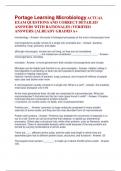Portage Learning Microbiology ACTUAL
EXAM QUESTIONS AND CORRECT DETAILED
ANSWERS WITH RATIONALES (VERIFIED
ANSWERS) |ALREADY GRADED A+
microbiology - Answer -the study of biological processes at the micro (microscopic) level
microorganisms usually consist of a single cell, examples are: - Answer -bacteria,
archaeons, fungi, protozoa, and algae
although microscopic, viruses are not living, so they are not considered
___________________, but instead are considered, ___________________ - Answer -
microorganisms, microbes
microbes - Answer -a more general term that includes microorganisms and viruses
Microbes can be helpful and harmful to us, give examples - Answer -Helpful: aiding in
food digestion to protecting us when we are exposed to potentially harmful foreign
invaders to helping crops grow
Harmful: harmful strains of bacteria, fungi, protozoa, and viruses kill millions of people
each year and sicken even more
A microorganism usually consists of a single cell. What is a cell? - Answer -the smallest,
most basic biological unit of life
At the most generalized level, all cells are comprised of macromolecules. What are
macromolecules? And what are the four main types found in cells? - Answer -Complex
molecules that are composed of smaller subunits
(1) proteins, (2) nucleic acids, (3) lipids, and (4) polysaccharides
Proteins are... - Answer -polymers (a large molecule comprised of many smaller
subunits) of amino acids, and they are the most abundant form of macromolecule
Protein cell functions - Answer -Proteins may facilitate the movement of materials in or
out of a cell. Some can act as enzymes that catalyze, or speed up, biochemical
processes. Others play a structural role, while other proteins, such as filaments, enable
movement. There is remarkable diversity within cells because of the way proteins are
formed by varying combinations of amino acids.
There are ____ different amino acids, and the order and length in which they are
assembled give rise to different protein sizes, structures, and functions - Answer -20
The largest known protein, _______, is made up of about 33,000 amino acids! - Answer
-titin
, # of essential essential amino acids, as the human body cannot produce them—they
must instead be taken in from the environment through other sources (i.e.) the food you
eat. - Answer -9
_______________ are chemical molecules that carry genetic information within the cell.
There are two major types of nucleic acids: DNA (deoxyribonucleic acid) and RNA
(ribonucleic acid). - Answer -Nucleic acids
DNA - Answer -contains a vast amount of hereditary information and is responsible for
the inheritable characteristics of living organisms
RNA - Answer -is responsible for deciphering the hereditary information in DNA and
using it to synthesize proteins
While both DNA and RNA can be found in the nucleus (center of the cell), only _____
can leave the nucleus. - Answer -RNA
Deoxyribonucleic acid (DNA) is made from building-block molecules called... - Answer -
nucleotides
Each nucleotide has three parts: - Answer -a nitrogenous (nitrogen-containing) base, a
sugar called deoxyribose, and a phosphate group
There are four kinds of nitrogenous bases that can occur in DNA nucleotides: - Answer -
adenine or guanine (purine bases) and cytosine or thymine (pyrimidine bases). The
bases can be abbreviated, A, G, C, and T
Strands of DNA form a ________________, meaning there are two strands held
together by hydrogen bonding - Answer -double helix
Complementary base pairings between _____ results in two hydrogen bonds being
formed, while G-C pairings results in the formation of _______ hydrogen bonds -
Answer -A-T
three
RNA contains the sugar _________ rather than deoxyribose - Answer -ribose
RNA is always _________-stranded, whereas DNA is double-stranded. - Answer -single
While RNA contains the bases adenine, guanine, and cytosine, it does not utilize the
pyrimidine base _________. Instead, RNA contains _________, which still pairs with
adenine (A). - Answer -thymine
instead has URACIL




